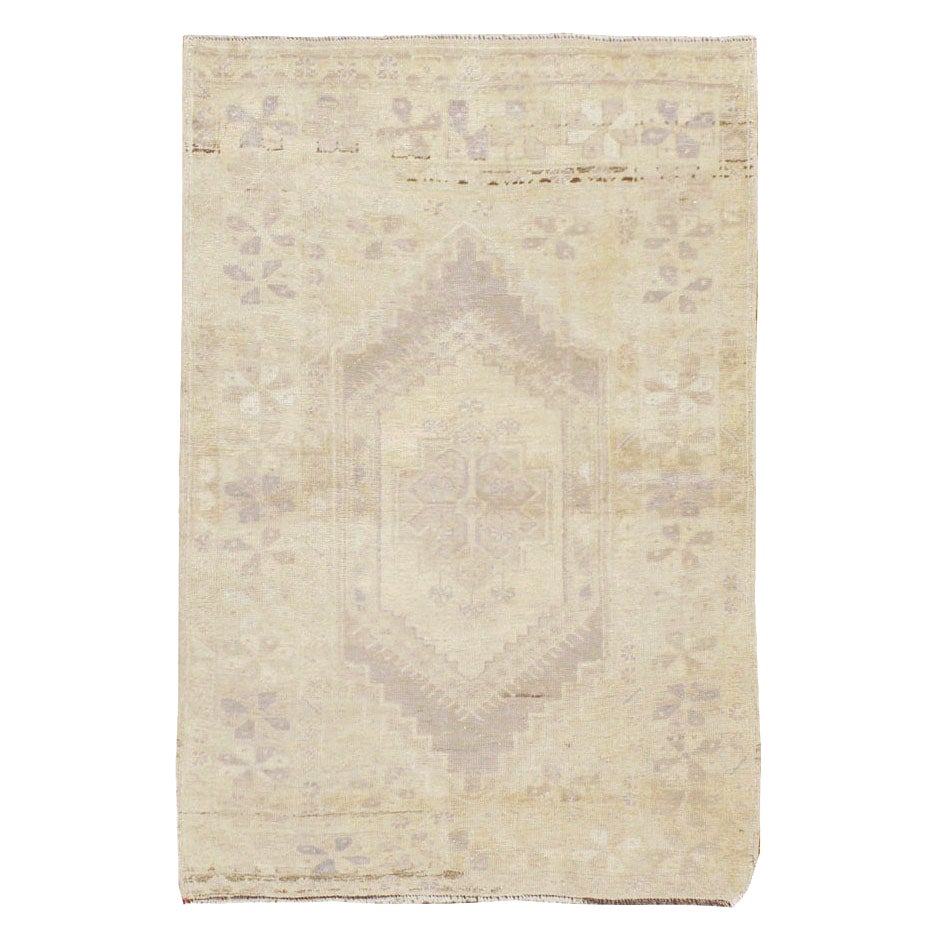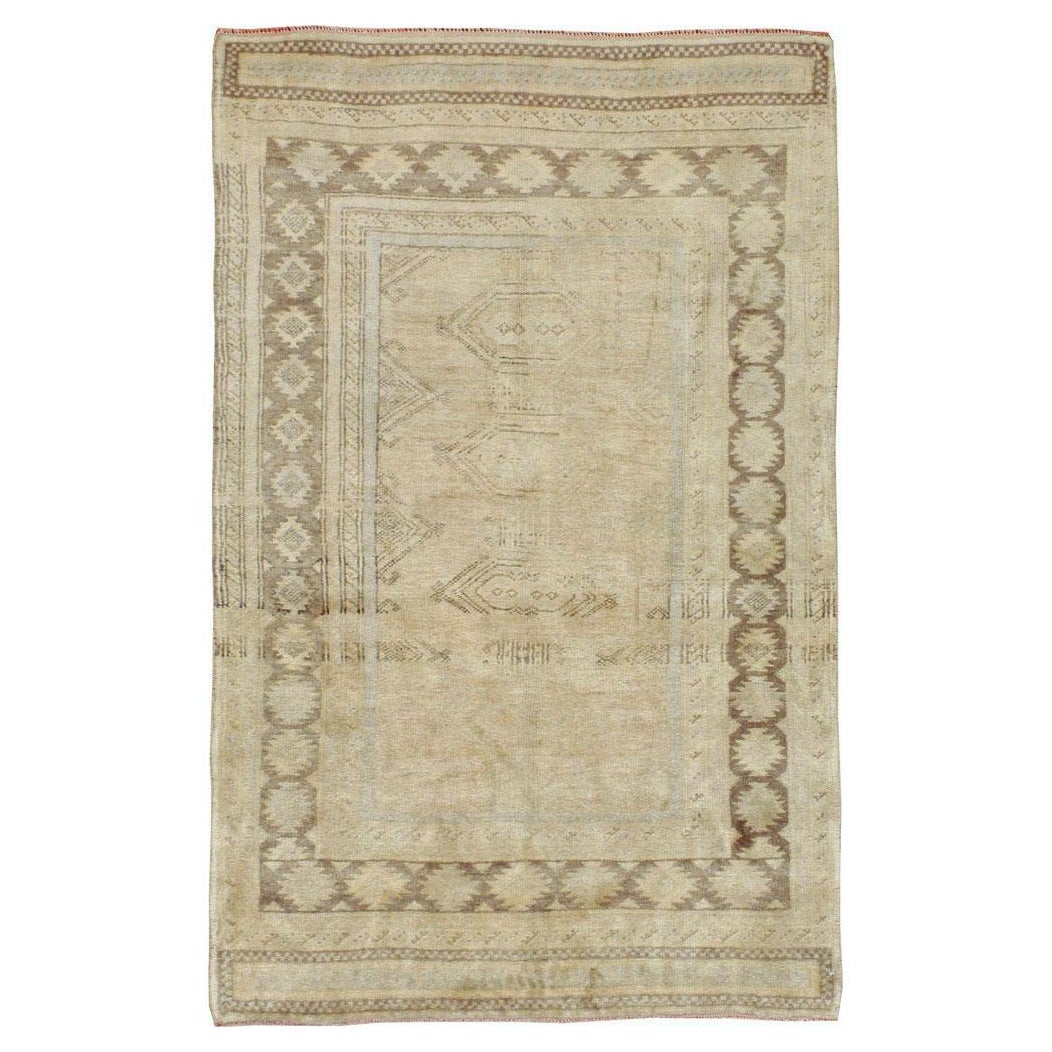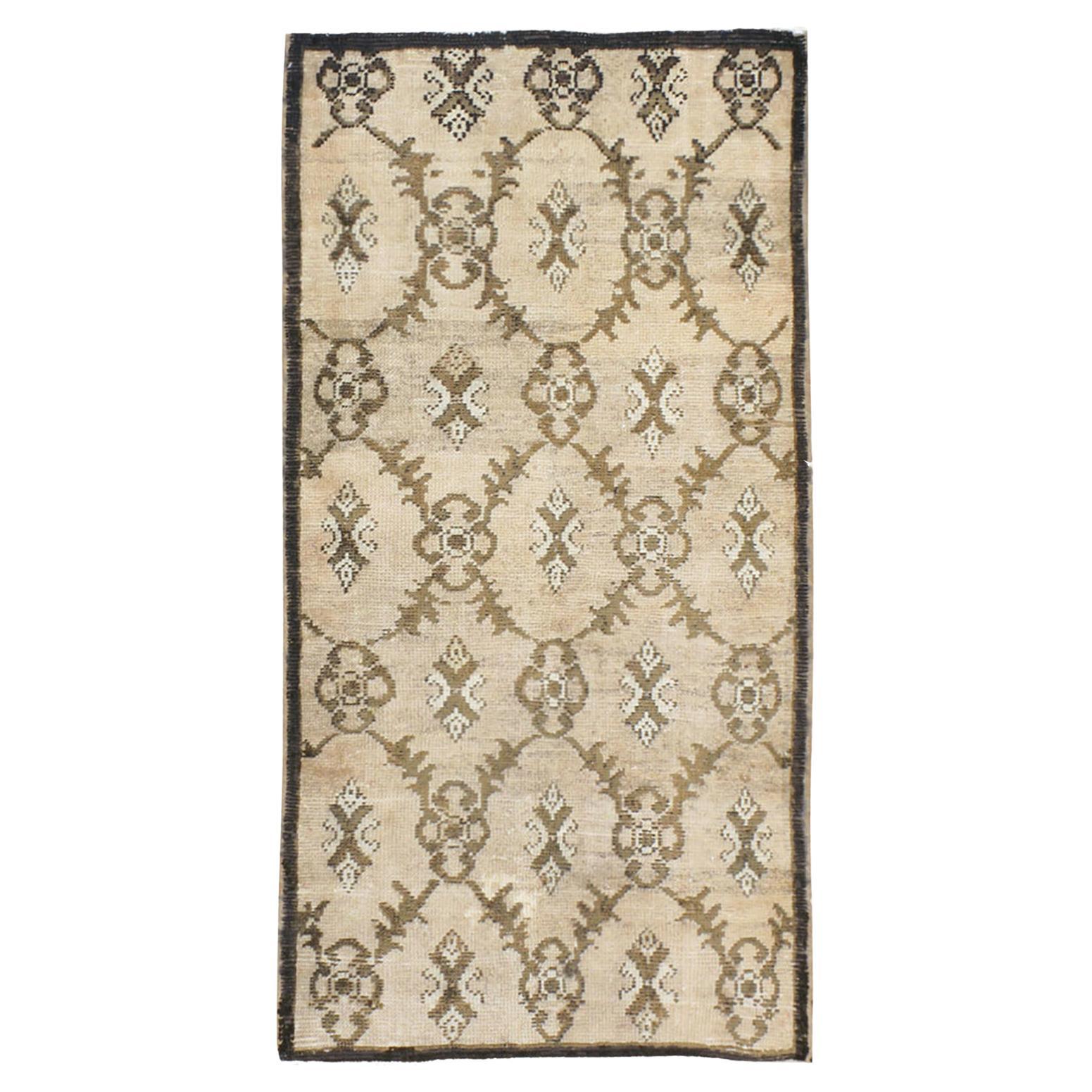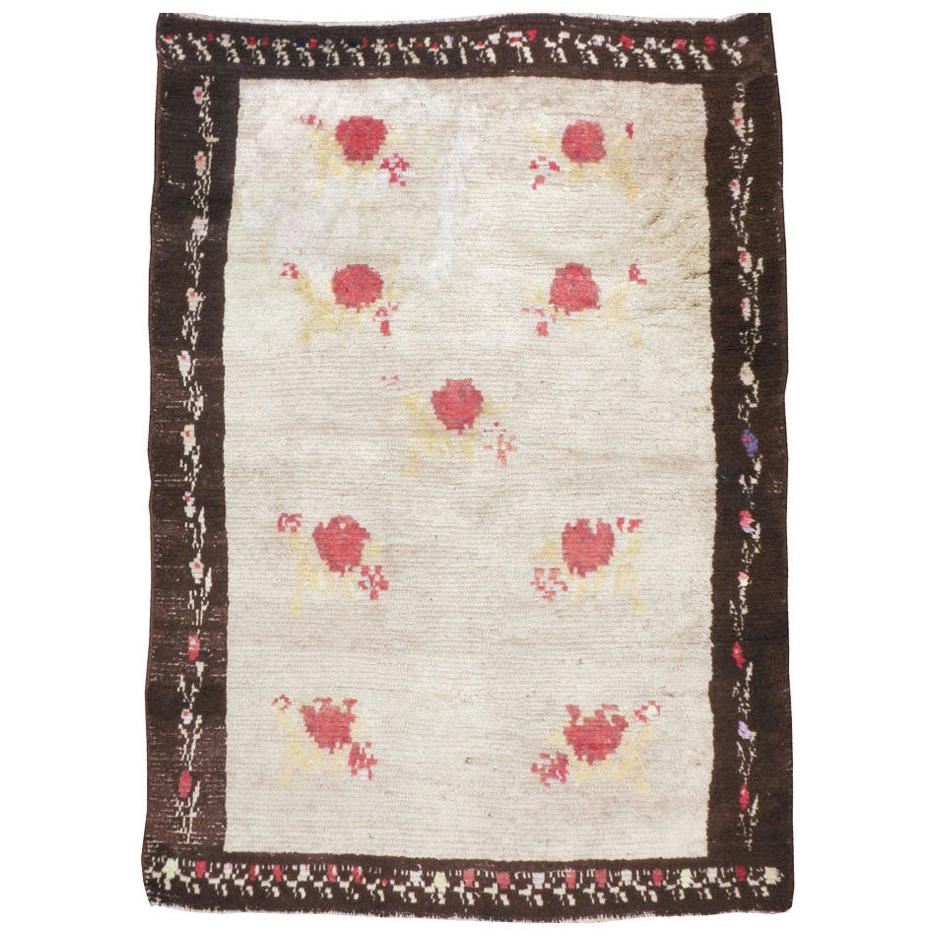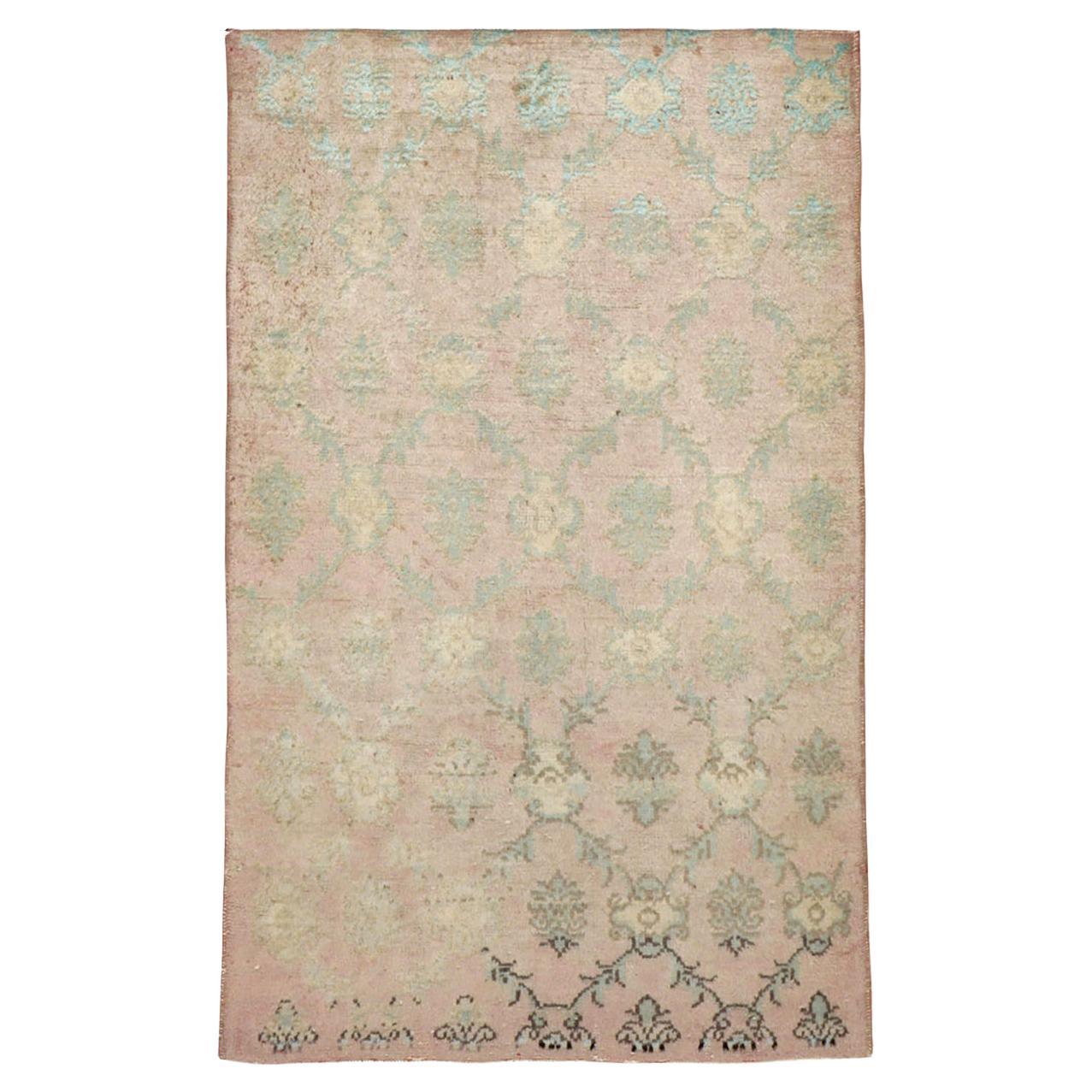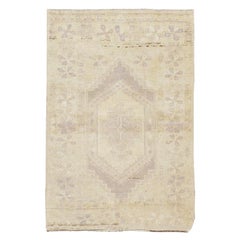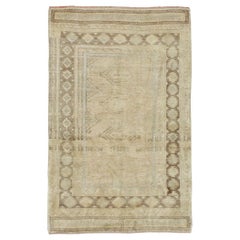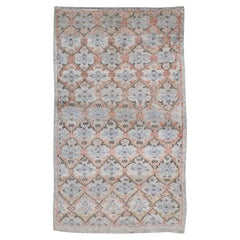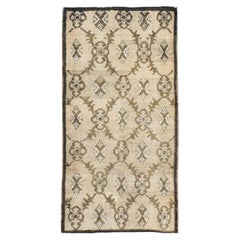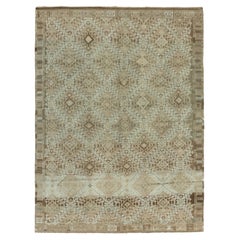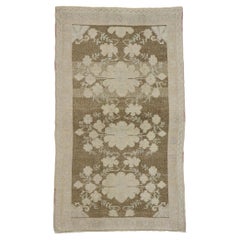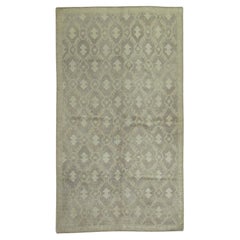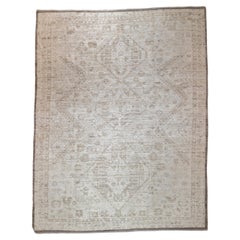Items Similar to Mid-20th Century Handmade Turkish Anatolian Throw Rug
Want more images or videos?
Request additional images or videos from the seller
1 of 9
Mid-20th Century Handmade Turkish Anatolian Throw Rug
$3,500
£2,672.23
€3,087.74
CA$4,913.34
A$5,476.43
CHF 2,873.29
MX$66,876.10
NOK 36,382.14
SEK 34,386.65
DKK 23,045.17
About the Item
A vintage Turkish Anatolian throw rug handmade during the mid-20th century.
Measures: 3'8" x 5'5".
- Dimensions:Width: 44 in (111.76 cm)Length: 65 in (165.1 cm)
- Style:Rustic (In the Style Of)
- Materials and Techniques:Wool,Hand-Knotted
- Place of Origin:
- Period:
- Date of Manufacture:circa 1940
- Condition:Additions or alterations made to the original: This carpet has been professionally antique washed to soften its tones.
- Seller Location:New York, NY
- Reference Number:Seller: 182901stDibs: LU882322133992
About the Seller
5.0
Gold Seller
Premium sellers maintaining a 4.3+ rating and 24-hour response times
Established in 1989
1stDibs seller since 2009
595 sales on 1stDibs
Typical response time: 1 hour
- ShippingRetrieving quote...Shipping from: New York, NY
- Return Policy
Authenticity Guarantee
In the unlikely event there’s an issue with an item’s authenticity, contact us within 1 year for a full refund. DetailsMoney-Back Guarantee
If your item is not as described, is damaged in transit, or does not arrive, contact us within 7 days for a full refund. Details24-Hour Cancellation
You have a 24-hour grace period in which to reconsider your purchase, with no questions asked.Vetted Professional Sellers
Our world-class sellers must adhere to strict standards for service and quality, maintaining the integrity of our listings.Price-Match Guarantee
If you find that a seller listed the same item for a lower price elsewhere, we’ll match it.Trusted Global Delivery
Our best-in-class carrier network provides specialized shipping options worldwide, including custom delivery.More From This Seller
View AllMid-20th Century Handmade Turkish Oushak Throw Rug
Located in New York, NY
A vintage Turkish Oushak throw rug handmade during the mid-20th century.
Measures: 3' 10" x 5' 10".
Category
Mid-20th Century Turkish Modern Turkish Rugs
Materials
Wool
Mid-20th Century Handmade Turkish Oushak Throw Rug
Located in New York, NY
A vintage Turkish Oushak throw rug handmade during the mid-20th century.
Measures: 3' 7" x 5' 7".
Category
Mid-20th Century Turkish Rustic Turkish Rugs
Materials
Wool
Mid-20th Century Turkish Anatolian Throw Rug
Located in New York, NY
A vintage Turkish Anatolian throw rug. A slightly curvy field tone lattice closely frames an offset, half-drop array of ivory quatrefoils with the narrowest of borders. The copious w...
Category
Mid-20th Century Turkish Rustic Turkish Rugs
Materials
Wool
Mid-20th Century Turkish Anatolian Throw Rug
Located in New York, NY
A vintage Turkish Anatolian throw rug. The abrashed sandy ivory ground of this rural Turkish scatter displays a three by three round and concave leaf lattice enclosing white and brow...
Category
Mid-20th Century Turkish Rustic Turkish Rugs
Materials
Wool
Mid-20th Century Handmade Turkish Anatolian Throw Rug
Located in New York, NY
A vintage Turkish Anatolian throw rug handmade during the mid-20th century.
Measures: 3' 6" x 4' 11"
Turkish Rugs & Carpets:
Until the Great Persian Carpet Revival in the later 19th century, the “Oriental rug” was Turkish. For nearly six centuries, Turkish rugs, both scatter, room size, and even larger, thoroughly dominated the European import market. Whereas the Persian carpet can be divided into urban, village, and tribal types, in Turkey and its predecessor the Ottoman Empire, rugs almost exclusively came from village weavers and from a small number of urban workshops. Ninety percent village, nine percent city, one percent tribal.
Turkish weavers have, with very few exceptions, always worked with the symmetric (Turkish) knot. Wool foundations are standard practice among both town and village weavers. The exceptions, very finely woven 20th century and recent Herekeh silks from near Istanbul, and early 17th century Ottoman Court rugs from Bursa, constitute only a tiny part of the total. Always pricey, they appealed and still appeal to the clients who want lots of knots and perfect execution instead of individual personality.
The urban workshops have been centered around the western Turkish city of Oushak and its attendant port town of Smyrna. Oushak weaves with the trends in fashion. When color saturated medallion carpets were needed, Oushak was ready in the 17th and 18th centuries. When coarse red and blue carpets were required, Oushak and Smyrna in the 19th century wove them by the boatload. When tastes changed again, and the European dealers in Smyrna wanted room size carpets with lighter and unusual colors, and with Persianate designs, production ramped up in nearby Oushak. Those antique, all-wool construction turn-of-the-century carpets are still in high demand with designers. Antique carpets with allover, roughly drawn patterns on grounds of shrimp, rust, straw, cream, pale blue, and pale and pea green, hitherto unavailable colors, are in such demand today that contemporary Oushaks have attempted to mimic them with soft palettes, extra-large scale drawing and coarse weaves.
Oushaks woven for the Turkish market, for palaces, houses and mosques were often oversize with large, repeating medallions, all in shades of (Turkey) red, dark blue, light blue-teal, and ivory, with lemon and green accents. Turkey, along with India, invented standard sizes. By vertically repeating the medallion, one could get one medallion, one with two end halves, two, three, etc. medallions, up to thirty or so feet in length. The process spared making new cartoons for each length and allowed a quicker turnaround time. Oushak, from the time of 15th century “Holbein” rugs onward, has always been a commercial center.
The prayer niche directional rug is primarily a Turkish development. In the towns and villages east of Oushak, in Ghiordes, Kula, Ladik, Kirsehir, Mucur and Konya, among others, arch pattern scatters with bright palettes and weaves varying from relatively fine to moderate were almost the entire production. Antique examples were particularly popular in America around 1900.
Other centers of village weaving were situated on the western coast and adjacent islands with the town of Melas and neighboring villages weaving geometric prayer rugs and scatters with a characteristic khaki green and lots of yellow.
The other large region was in the northwest of Anatolia, near ancient Troy, with the sizable town of Bergama at its center. The satellite towns of Ezine, Karakecilli, Yuntdag, and Canakkale all wove colorful scatters with moderate weaves in all wool with geometric designs and cheerful palettes. Near to Istanbul, these were among the first Turkish rugs to reach Europe in the Renaissance.
The earliest Turkish pieces depicted in Italian Old Master paintings display the so-called “Memling gul”, an allover panel pattern with hooked and stepped elements within the reserves. This pattern continues for centuries in the Konya area and in the Caucasus as well.
Turkey is a land of villages and much of the most interesting Turkish weaving comes from one undiscovered village or another. The Konya-Cappadocia region of central Turkey includes the active towns of Karapinar, Karaman, Obruk, Sizma, and Tashpinar, all weaving Konya-esque scatters and long rugs. Karapinar has been active the longest, since the 17th century. The mosques in and around Konya have preserved locally-made rugs from the fourteenth. In the 20th century, the extra-long pile, many wefted Tulu rug was devised, with limited palettes and color block patterns. These are not really antique Tulus, but they must be a product of long-standing village tradition.
There are thousands upon thousands of rural Turkish villages, almost all with easy access to local tribal wool. Rug students are discovering new names and rug types almost daily. The common denominators are bright colors, geometric designs, wool construction, moderate to coarse weaves and symmetric knots. Synthetic dyes hit the Turkish rug industry quickly and hard after 1870, and they penetrated to even the most off-the-beaten-track villages. This development was almost entirely negative. The village weavers used fugitive or overly bright dyes which ruined the color harmonies built up over centuries. Characteristic types disappeared or were negatively transmuted. The Turkish village rug of the 1870 to 1920 period is nothing to be proud of.
In the eastern provinces, the semi-nomadic Kurdish tribes, collectively called ‘Yuruks’, weave all wool, geometric pieces with medium to medium-coarse weaves, as well as kilims and other flatweaves. The rugs employ cochineal instead of madder for the reds, mustard yellows, greens, and various blues. They are under-collected like the Persian Afshars. Their rugs are in scatter and long rug formats. The far eastern Turkish town of Erzerum has a long tradition of idiosyncratic, semi-workshop rugs and further to the east is Kars with a tradition of rugs in the Caucasian Kazak manner.
One Turkish specialty is the Yastiks or cushion cover, made in pairs for the public living rooms of village houses. These are larger rugs in miniature and good ones are highly collectible. Like other Turkish rustic weavings, ones with synthetic dyes are almost totally undesirable. Only the tribal Baluch make similar cushion covers, known as pushtis or balishts, in the same small, oblong format. Yastiks always have a back, usually in plain weave, so that they can be easily stuffed.
When the Imperial Carpet Factory at Herekeh near Istanbul closed in the early 20th century, the highly proficient Armenian master weavers set up in the Kum Kapi district of Istanbul where they wove all-silk, exquisitely fine and elaborately detailed small pieces, sometimes enriched with metal thread, for the most discriminating European buyers. Today the best, signed Kum Kapi pieces, usually in the “Sultan’s head” prayer niche design, can fetch upwards of $100,000. They are strictly for the wall. An Interwar all-silk room size Kum Kapi carpet is both exceedingly rare and stratospherically priced. The workshops closed in the 1930s, but the weaving of extremely fine, all-silk small rugs in Herekeh was revived in the 1960s.
There has been a recent vogue for larger Turkish village vintage...
Category
Mid-20th Century Turkish Rustic Turkish Rugs
Materials
Wool
Mid-20th Century Turkish Anatolian Throw Rug
Located in New York, NY
A vintage Turkish Anatolian throw rug. This rustic Anatolian small scatter has an almost totally subdued field with only a snippet of the original brown palmette and stem pattern rem...
Category
Mid-20th Century Turkish Rustic Turkish Rugs
Materials
Wool
You May Also Like
Vintage Turkish Kilim Rug 5'6 X 7'2
Located in New York, NY
5'6 X 7'2. Handwoven in the 1940s, this vintage Turkish flat-weave Kilim exemplifies timeless craftsmanship. Its bold geometry and understated elegance create a striking balance—equa...
Category
20th Century Turkish Oushak Turkish Rugs
Materials
Wool
Vintage Turkish Oushak Rug with Modern Farmhouse Style
Located in Dallas, TX
53627 Vintage Turkish Oushak Rug with Modern Farmhouse Style 02'11 x 04'11. Emanating timeless appeal, effortless beauty and neutral hues, this hand k...
Category
Late 20th Century Turkish Oushak Turkish Rugs
Materials
Wool
$2,000 Sale Price
20% Off
Zabihi Collection Vintage Turkish Konya Decorative Rug
Located in New York, NY
Mid-20th century Turkish Konya rug
Measures: 4'9'' x 7'8''.
Category
Mid-20th Century Turkish Mid-Century Modern Turkish Rugs
Materials
Wool
Fine Vintage Turkish Oushak Wool Rug 8'1'' x 10'4''
Located in New York, NY
Fine Vintage Turkish Oushak Wool Rug 8'1'' x 10'4''.
Category
Late 20th Century Turkish Turkish Rugs
Materials
Wool
Vintage Mid-Century Modern Turkish Tribal Jajim Flatweave Rug
Located in New York, NY
The Mid-Century Modern Collection is skillfully sourced by N A S I R I and exclusive to our showroom. These flatweaves embody the minimalist sophistication that emerged in the mid-20...
Category
Vintage 1960s Turkish Tribal Turkish Rugs
Materials
Wool
$8,000 Sale Price
20% Off
Vintage Turkish Kars Rug with a Modern Design in Shades of Brown and Ivory
Located in Atlanta, GA
Measures: 7'7 x 10'4.
This wonderful Turkish rug, from eastern Turkey, displays a chocolate brown background with a small, repeating geometric pattern in the background and border.
...
Category
Vintage 1940s Turkish Modern Turkish Rugs
Materials
Wool
$7,600 Sale Price
20% Off
More Ways To Browse
Unique Gold Coffee Table
Used Luxury Sofas
White Ash Table
White Laminate Table
1960 Walnut Dining Table
Dedar Fabric
Elephant Silver
End Table Turned Leg
Glass Midcentury Coffee Table Round
Green Desk Midcentury
Silver Plate Birds
Wood Pillar
Antique Barley Twist Furniture
Blonde Vintage Furniture
Brancusi Constantin
Chinese Village
Coffee Table Canada
Crackle Ceramics
